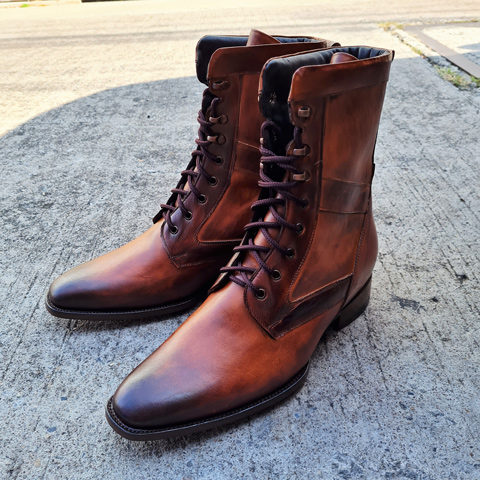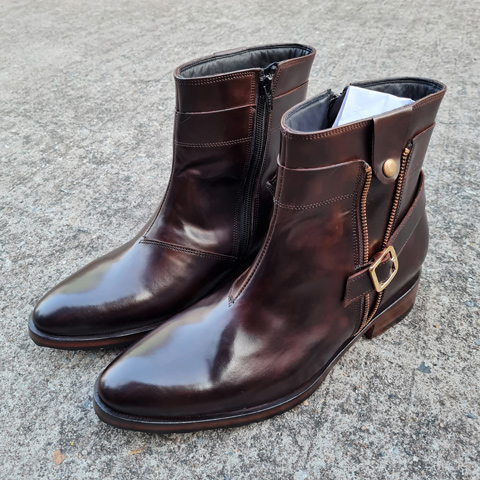It seems as though there was quite a bit of interest in an old article of mine, “Everything you Wanted to Know About Elevator Shoes, But Were Afraid to Ask…”
From the feedback, I’d like to take a few minutes out to address some of the most common follow-up questions and comments I’ve received since writing the post.
Right off the bat, I wanted to address the question of hiding the “weird, bulky curve” on the backs of 4 inch and 5 inch elevator shoes.
In the old article, I reviewed a few different strategies on how to conceal the discrepancy.
In retrospect, I realized that I didn’t focus on a critical detail—that the blatantly obvious, aesthetically unappealing bump in most 4-5 inch elevator shoes, is not present with Don’s 4 and 5 inch height increasing shoes.
As you could see in the photo that accompanied the original posting, or in the image below, Don’s shoes go for a longer shaft, which allows for the lift to be hidden in the shoe much more effectively, and without the need for the extensive bulging seen in other elevator shoes.

Of course, special requests asking for extreme lifts (5.5 to 6 inches and up) will run against the need to expand the back of the shoe; but the designs used for 4 and 5 inch shoes will be a “night and day” difference compared to their counterparts from other manufacturers.
As someone who owns multiple pairs of 4 and 5 inch elevator shoes from Allan (the owner and master craftsman of Don’s Footwear), I have literally never had an instance where I have had to tailor a single piece of clothing to “work around” the design of the shoe. It’s a HUGE improvement from the sorts of bulky, blocky “medical shoes” that I’d come to accept for years.
Q: How do you deal with “that embarrassing moment” on a date when you finally have to take off your shoes for the first time, and your date that you’re not as tall as they thought?
A: I’ve heard some pretty outrageous suggestions for workarounds—everything from socks with insoles, to keeping “elevator slippers” on hand to swap into at a moment’s notice. To be honest, though, in my personal experience, none of it’s been particularly necessary.
As I outlined in my most recent post, I’m firmly of the opinion that the most critical phase where your height is going to matter is in your first few interactions. At that early stage, the woman you’re speaking to hasn’t had a chance to discover your intellect, your sparkling sense of humor, the way you make her feel, your incredible talents, or anything else hiding beneath the surface. In those first few moments, all she has to work with is what’s visible at first glance. In those moments, she can make a snap decision based on her general preferences, that might “set the tone” of the rest of the interaction if her first instinctual reaction isn’t to view you as a potential partner based on her “typical” criteria.
Of course, all of us have make similar “snap impressions” of other people every day, and we’ll never know just how many times we might have completely misjudged the people around us, or how many amazing opportunities we may have missed out on because of assuming things about the people around us before we took the time to get to know them better.
Thankfully, in this case, elevator shoes can be a simple solution to work around the unconscious habit some potential partners may have to put you into the “not a potential partner” box based on a height discrepancy. With that snap judgement out of the way, a prospective partner is open to get to discover the real you; once they do, if its genuinely a magical, powerful connection, any difference that comes up after the fact is dealt with as a shrug or a laugh. In 10 plus years of wearing height increasing shoes, I have literally never had a situation arise where taking them off has led to a break-up, an argument, or any other dramatic source of tension.
If improving your dating prospects are a serious consideration in height increasing shoes, remember that they’re literally just there to open the door for you. Once you’ve avoided being “screened out,” you can give your charm, conversation and charisma a chance to shine.
Q: Why not just use insoles / inserts?
A: To be honest, inserts can be a perfectly reasonable solution for those looking for a very minor increasing in height—saying, half an inch in total. For those looking for more, though, they can create a few issues, in my experience.
Firstly, it’s possible that the insole can push your feet more snuggling against the shoe than intended; which can potentially cause callousing, discomfort, or other negative effects over time.
To avoid that, or to allow for a much more substantial increase, I’ve sometimes seen (and personally attempted) the solution of buying an oversized shoe, and using the extra space to fit in a larger insole.
While this solution can be much more comfortable than trying to fit a significant lift into your normal sized shoe, it comes with a major problem. Since the shoe is much longer than your foot, when you step, most shoes will fold very awkwardly—and very noticeably—with every step you take.
When I was trying this solution myself, it was extremely frustrating, since it seemed to be a much more comfortable solution than the unappealing , heavy, blocky shoes that I once thought were the only alternative.
In the end, though, I couldn’t ignore the fact that it was far too obvious that there was something visibly “strange” with how my feet appeared in the shoes as I walked.
Q: Have you experienced any notable long-term effects with wearing height increasing shoes?
A: Yes and no.
I described in the original post, I definitely felt soreness when I wore heavy and bulky 4-5 inch elevator shoes. The weight of them was simply so much heavier than a normal shoe that it created significant strain on my ankles. It reached a point where going out dancing or for long walks led to a soreness the next day that would sometimes make it hurt to stand or walk.
Likewise, I can definitely say that I’ve had experiences with poorly designed shoes that left me feeling like my arches were being put under excessive strain; I sometimes worried if there would be long-term damage if I didn’t take action.
Thankfully, I was able to find solutions for both issues.
The soreness I’d endured from the 4 inch and 5 inch elevator shoes disappeared when I switched to buying from Allan at Don’s Footwear. That’s not a shameless plug, it’s simply the reality that Don’s made their height increasing shoes substantially lighter, and with what I feel is an incomparably better design. The difference in weight, combined with the form factor benefits of the boots having longer shafts, puts much less pressure on the ankle and results in a completely different (and MUCH more comfortable) experience.
The first solution basically solved the second issue as well; with the shoes being so much more comfortable, I’ve become much less worried about long term strain on my joints. In the long run, though, I can imagine if anyone was especially sensitive, that simply choosing shoes with a slightly reduced lift should hopefully resolve the issue completely. (Of course, each person is different, and I’m no doctor—so please listen to your body first and foremost!)
Of course, if you have any other questions, please continue to reach out, and Allan will be happy to get in touch with you directly.


